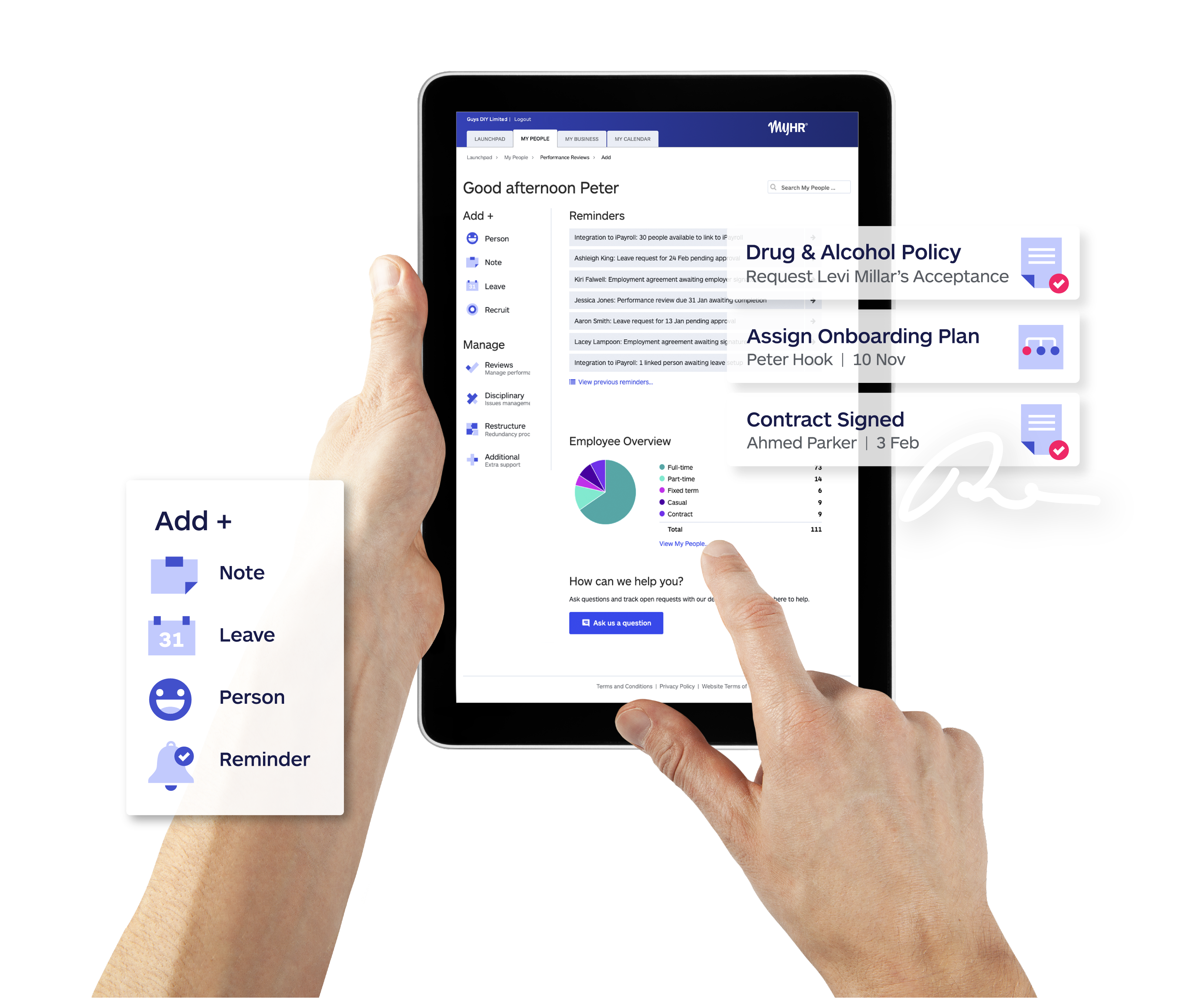Hiring a new team member requires significant effort. From crafting and posting the job description ad, reviewing resumes, conducting interviews, checking references, and assessing candidates, it’s a time-consuming and labor-intensive process.
After all that work, the last thing you want is to hire someone who turns out to be a poor fit for the role or company, forcing you to start the process all over again.
But it happens. Recruitment isn’t an exact science. While we all aim to hire the best person for the job and organisation, various factors—bias, omissions, or over-reliance on one selection criterion—can lead to mistakes.
At MyHR, we work closely with Canadian businesses of all sizes on their hiring needs. Here, we highlight some of the most common recruitment mistakes Canadian employers are making, and how to avoid them.
9 common hiring mistakes to avoid
Lacking a structured hiring process
Lacking a structured hiring process is a critical mistake when it comes to recruitment. A disorganised approach to hiring can undermine your ability to attract and assess top talent effectively.
Each step of the recruitment process plays a role, and no single element guarantees success. You may have an attractive job posting that draws skilled applicants, but if your interview process is unstructured or your candidate selection is inconsistent, you may not hire the best person.
A structured process helps ensure consistency and makes it easier to assess and refine your hiring approach for future roles.
Additionally, most applicants will not be selected, and a poorly managed recruitment experience can damage your company’s reputation. Be professional—honour time commitments, communicate proactively, and ensure candidates feel respected throughout the process. After all, although a candidate may not be the best fit for a particular role, there’s nothing to say a better match won’t arise for them in the future.
Consider the following when setting up the structure of your interviews, a structured process includes:
- The number of interviews you plan to conduct
- What format the interview will take - phone, online, in person
- What are the core skills and abilities are you looking for
- How quickly you will get back to applicants to schedule them in for an interview
- How and when will you follow up with unsuccessful applicants that you interview
- How you will conduct reference checks
Letting candidates who make it to the first interview know what the interview process will look like and how long it will take is a great way to demonstrate professionalism and build confidence with the candidate that they are interviewing with a business that values their employees.
Posting unclear job descriptions
Starting the hiring process without a well-defined job description is a fundamental error. Many employers fail to identify their current and future needs before beginning recruitment, allowing the hiring process to shape the role rather than the other way around.
A clear, accurate job description sets expectations for both the employer and candidates. Ask yourself: What tasks does this role involve? What qualifications, skills, and attributes are essential?
However, balance is key—avoid overly detailed descriptions that might overwhelm or confuse potential candidates. Click here to learn more about creating an effective job description.
Overselling the role
In an effort to attract top talent, employers may falsely assume that the flashier the job description, the better the applications they will receive. There might be an impulse to exaggerate the role’s responsibilities, growth opportunities, or compensation. However, new hires will quickly discover the reality, leading to disengagement or early resignation.
Be upfront about the role’s challenges and rewards. Setting realistic expectations fosters trust and helps you attract candidates who are genuinely suited for the position.
Over-reliance on resumes or references
Spending excessive time analysing resumes or relying too heavily on references can be misleading.
Resumes
Resumes don’t always accurately reflect a candidate’s skills or experience—details can be exaggerated or misrepresented. A resume should be a tool to shortlist candidates quickly. Look for consistency, professionalism, and alignment with your requirements. Cross-check information with LinkedIn or other professional profiles and flag any details that seem questionable.
If you are not sure about a candidate, schedule a screening call and spend a few minutes asking key questions that tell you if the candidate will be a fit for the role. If they are, you can schedule an interview while you have them on the phone.

While resumes are a great screening tool, they should not be relied upon too heavily. A complete hiring process typically includes interviews after reviewing resumes submitted.
References
References can provide valuable insights but should supplement, not replace, a thorough interview and assessment process. Remember, candidates typically choose referees who will speak positively about them, so ask targeted questions about strengths and areas for improvement.
Poor interview techniques (or asking the wrong questions)
Interviews are the real opportunity to assess candidates, but they are often conducted inconsistently or ineffectively.
Interviewing is a skill that requires preparation. Avoid overly informal chats or high-pressure interrogations. Instead, create a structured yet comfortable setting that encourages candidates to share their experiences and abilities.
Use a mix of standardised and open-ended questions to evaluate technical skills, problem-solving abilities, and cultural fit. Ask for examples of situations in the candidates past work experience that demonstrate the skill you are looking for.
Example “Tell me about a challenging customer you had to deal with in your previous role. What was the situation, and how did you deal with it?”
Ensure candidates do most of the talking—aim for an 80/20 balance, with the interviewer speaking only 20% of the time. A great way to round out the end of the interview and ensure you are learning as much as you can from the candidate is to ask, “Is there anything else I should know about your experience?” and “what questions do you have for me?”
To ensure you are not letting your biases get the better of you, be sure to ask each candidate the same question so you can compare their answers. This is also important should you ever be challenged on being discriminatory during the hiring process.
Overlooking internal talent
Many companies assume the best candidates are external, overlooking their existing workforce.
Hiring internally saves time and costs, as current employees already understand your company’s culture, processes, and goals. Promoting from within can also boost morale and employee retention, demonstrating clear career progression opportunities.
Be sure to let your team know you are hiring for a new role and that they are welcome to apply. Interview internal candidates the same way you would external candidates so you have a way to compare all applicants.
Waiting for the "perfect" candidate
Holding out indefinitely for an ideal candidate can put undue strain on your team and operations.
If multiple rounds of job postings aren’t yielding results, reassess your expectations—are they realistic? Consider whether your job posting is positioned correctly or if your compensation and benefits package is competitive.
If you’re struggling to find the right candidate, flexibility in your requirements or additional training opportunities may be a better long-term solution than keeping a role vacant for too long.
Short-term thinking
Filling an immediate gap is important, but recruitment should also align with your company’s long-term goals. Employees seek growth and development, and hiring with the future in mind ensures new team members can evolve with the company.
Think about where you see your business in a year. What new roles might you have, and where could your new employee fit in the future?
Neglecting onboarding
One of the most common hiring mistakes is failing to properly onboard new employees well. We encourage people to consider the hiring process ongoing until your new employee is a couple of weeks into their new role.
Once a candidate accepts the offer, ongoing communication is essential to keep them engaged before their start date. Provide essential documents, policies, and access to any necessary tools in advance.
On their first day, ensure everything is set up for a smooth transition. Assign a mentor or “buddy” to help them integrate into the team. Employees typically take about three months to become fully productive, so providing structured support during this period is crucial.
If you notice consistently high turnover within the first 90 days (whether that be management's or the employee’s choice), the business’s onboarding process could be a factor. Reviewing and improving your hiring and onboarding process is a worthwhile investment.
Learn more about effective onboarding
Our HR advisors would love to help you review your recruiting and onboarding process to make sure you are attracting and retaining the best possible candidates for your business. Get in touch today.

